“Errand of Mercy”
Written by Gene L. Coon
Directed by John Newland
Season 1, Episode 27
Production episode 6149-27
Original air date: March 23, 1967
Stardate: 3198.4
Captain’s log. The Enterprise has received word that negotiations between the Federation and the Klingon Empire have broken down. A surprise attack is expected. Kirk has been ordered to go to Organia—the only Class-M planet in the disputed area between the nations—to keep the Klingons from using it as a base. En route, the Enterprise is ambushed by a Klingon ship, but they are able to destroy it. Right after that, Uhura gets a Code 1 message from Starfleet Command: it’s war.
When they arrive at Organia, Uhura relays a report that there’s a Klingon fleet in the sector. Kirk and Spock beam down, with the captain leaving Sulu in charge. If the Klingon fleet shows up, Sulu’s orders are to evaluate the situation, and abandon Organia to join the fleet.
The Organians are pretty blasé about two guys beaming down out of nowhere. They are greeted by Ayelbourne, one of the Council of Elders. While Spock checks out the village, Kirk speaks to the council, offering them protection from the Klingons. The Organians, however, have no interest in being protected. Kirk’s stories of slave labor camps and the military dictatorship of the Klingon Empire destroying their way of life fall on deaf ears. Spock also reports that the Organian culture is stagnant, and unchanged for tens of thousands of years.
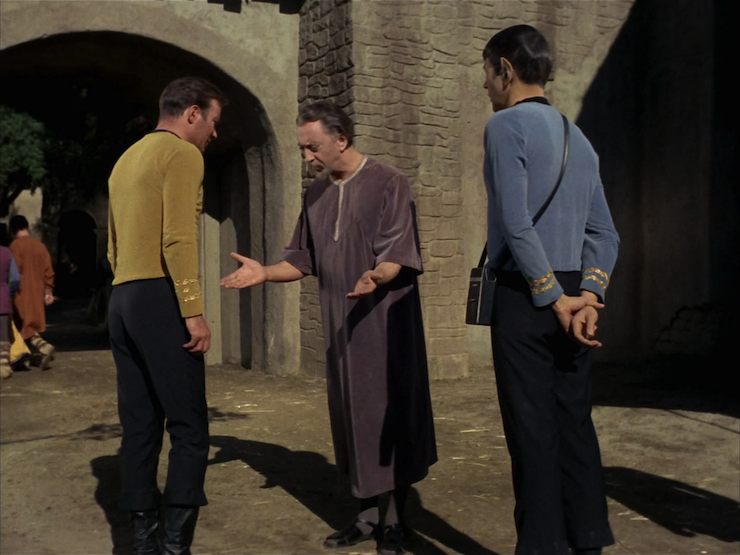
A Klingon fleet shows up in orbit. Sulu retreats on Kirk’s order, and the Organians offer to protect Kirk and Spock from the occupation force that beams down by giving them native clothing (and also confiscating their weapons). The Klingon commander, Kor, enters the council chambers, introducing himself as the military governor of Organia. Kirk identifies himself as Baroner, and Kor notices that “Baroner” is the only Organian who doesn’t smile like an idiot. Spock claims to be a trader in kevas and trillium. Kor orders him taken away for interrogation, as he might be a spy. Kor chooses Kirk to be the liaison between the occupying government and the civil population, as he finds his “good, honest hatred” to be refreshing. The Organians themselves are completely cooperative with Kor’s demands.
Spock is interrogated using the Klingon mind scanner, and while his telepathic discipline enables him to maintain the fiction of his disguise, it is a close call. Kirk would not be so lucky if he was to be subjected to it.
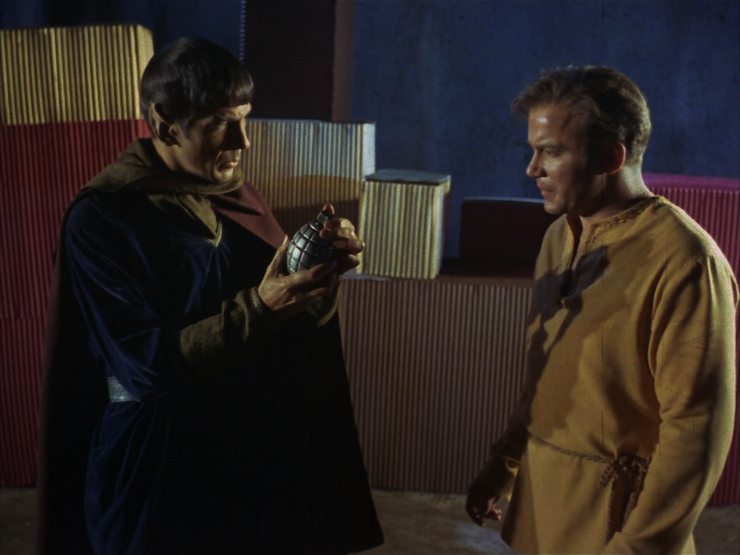
Kirk and Spock blow up a munitions dump. Ayelbourne and the rest of the council are aghast at their violent act. Kor has the council chambers under surveillance, so he knows who blew up the munitions dump, and puts Kirk and Spock under arrest. Rather than let Kirk be subjected to the mind scanner, Ayelbourne tells Kor who Kirk really is. Kor is thrilled that he has captured a starship captain, though he’d been hoping to meet Kirk in battle, not like this.
Kor shares a drink with Kirk and they talk for a bit, then Kor has him put in a cell alongside Spock. They are still determined to carry out their mission, even though the Organians themselves don’t seem to give a rip.
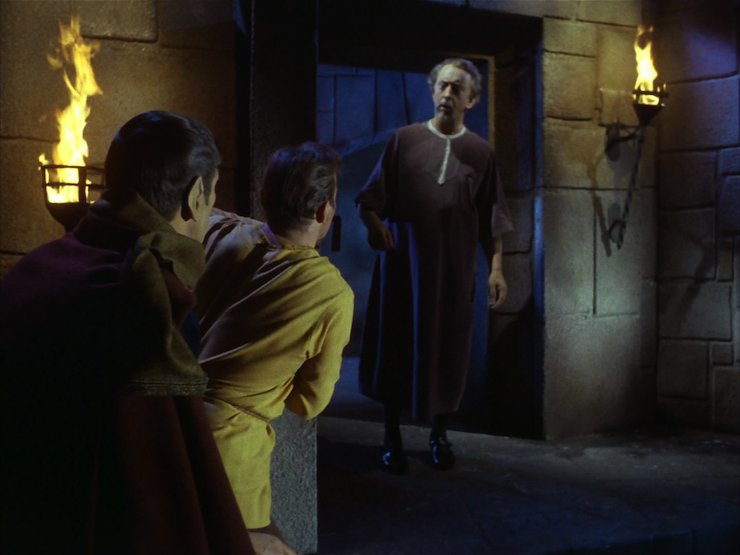
Then Ayelbourne frees them from the cell. Kirk is confused, especially since Ayelbourne betrayed them to the Klingons in the first place. Upon learning that they’ve escaped, Kor orders two hundred Organians killed. Ayelbourne and the others are completely unconcerned about this. However, they reluctantly give Kirk and Spock their phasers back, just to get them off their backs. The pair break into the citadel, taking down several of Kor’s people, and eventually breaking into Kor’s office and taking him prisoner. Kor is fairly philosophical about being captured. There’s a Federation fleet en route to engage the Klingon fleet in space.
Just as Kor’s guards burst in, everyone’s weapons become too hot to touch. In space, the same thing happens on the Enterprise, as all the ship’s instruments become untouchable. Ayelbourne and Claymore enter and explain that it’s their doing. They have rendered both fleets inoperative and insisted that they stop the violence or the fleets will remain paralyzed. Kor and Kirk are outraged, saying that they have no business interfering in interstellar matters, but Ayelbourne points out to Kirk that what he is defending is the right to wage war. Even as he speaks to Kirk and Kor, Ayelbourne is also on Earth and Qo’noS, insisting that they stop the war.

It becomes quickly apparent that the Organians’ humanoid form is a fiction, one to provide a point of reference for corporeal beings who might visit. In fact, the Organians are beings of pure energy who find the presence of such violent, emotional beings as the humans and Klingons to be disgusting. They force peace upon both nations, which embarrasses Kirk (he was so outraged that the Organians wanted to stop a war he never even wanted to fight in the first place) and disappoints Kor (who thought the war would’ve been glorious).
Fascinating. Spock poses as a merchant dealing in kevas and trillium and is sufficiently awesome that he can blow past the mind scanner.
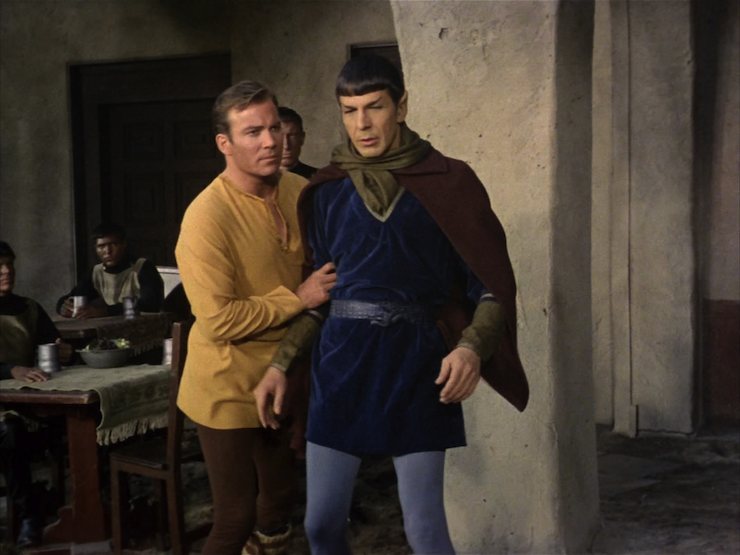
I’m a doctor not an escalator. This is the last episode of the series in which DeForest Kelley doesn’t appear.
Ahead warp one, aye. As with “Arena,” Sulu is left in charge of the ship in a battle situation. And as with “Arena,” he’s reluctant to not beam the landing party back up.
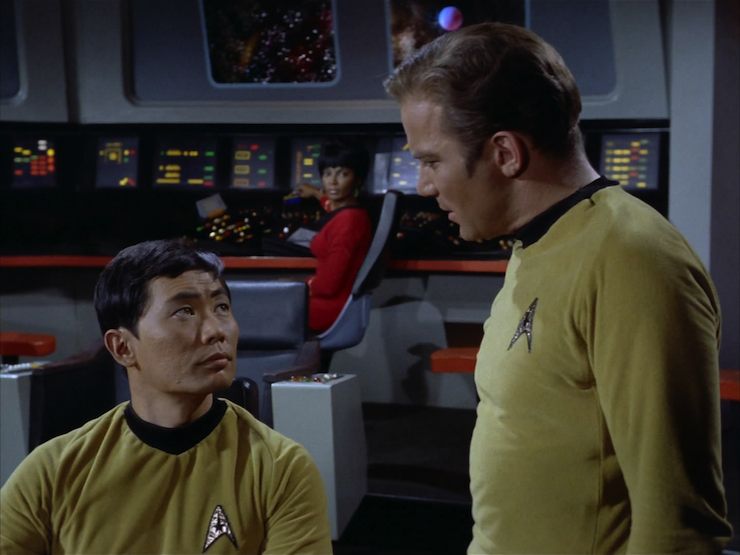
Hailing frequencies open. Uhura’s job in this one is bearer of bad tidings: that negotiations have broken down, that there’s a fleet in the area, and that war has broken out.
Channel open. “What would you say the odds on our getting out of here?”
“Difficult to be precise, Captain. I should say approximately 7824.7 to one.”
“Difficult to be precise?”
Kirk discussing the situation with Spock and ignoring Han Solo’s advice about odds.
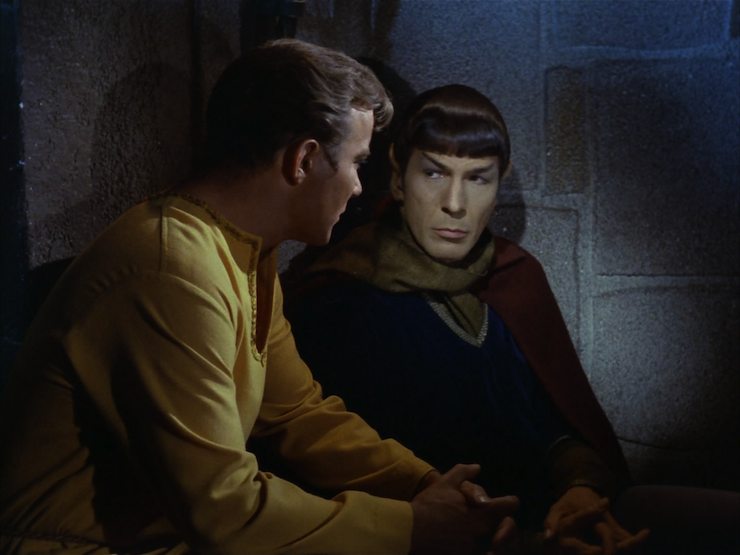
Welcome aboard. John Abbott, Peter Brocco, and David Hillary Hughes play the Organians, while Victor Lundin, Walt Davis, and George Sawaya play various Klingons. Plus we’ve got recurring regulars George Takei and Nichelle Nichols.
But the main guest is the great John Colicos as Kor, our first Klingon, and the man who set the tone for the species going forward. The character will return in the animated episode “The Time Trap” (voiced by James Doohan), and Colicos will return as a much older Kor on three DS9 episodes, “Blood Oath,” “The Sword of Kahless,” and “Once More Unto the Breach.”
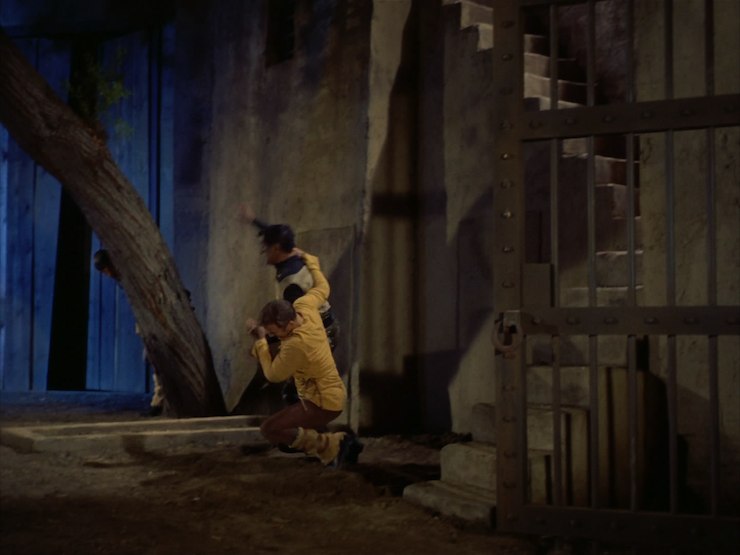
Trivial matters: This episode introduces an enemy of the Federation known as the Klingons. Always thought they should’ve done more with them…
But seriously, folks… The Klingons will become the most popular recurring antagonist for Kirk and the gang, showing up again in “Friday’s Child,” “The Trouble with Tribbles,” “A Private Little War,” “Day of the Dove,” “Elaan of Troyius,” and “The Savage Curtain” on the series, as well as the films The Motion Picture, The Search for Spock, The Voyage Home, The Final Frontier, The Undiscovered Country, and Star Trek Into Darkness, as well as playing important roles on all four spinoffs. Indeed, three of those spinoffs will have a Klingon in the opening credits.

The lead-up to this war is seen in Kevin Ryan’s two trilogies Errand of Vengeance and Errand of Fury. The final book of the latter trilogy is a novelization of this episode, greatly expanding the events, including details of Sulu’s engagements while in command of the Enterprise.
Following this episode, peace between the Klingons and Federation will be managed via the Organian Peace Treaty, as established in “The Trouble with Tribbles.”
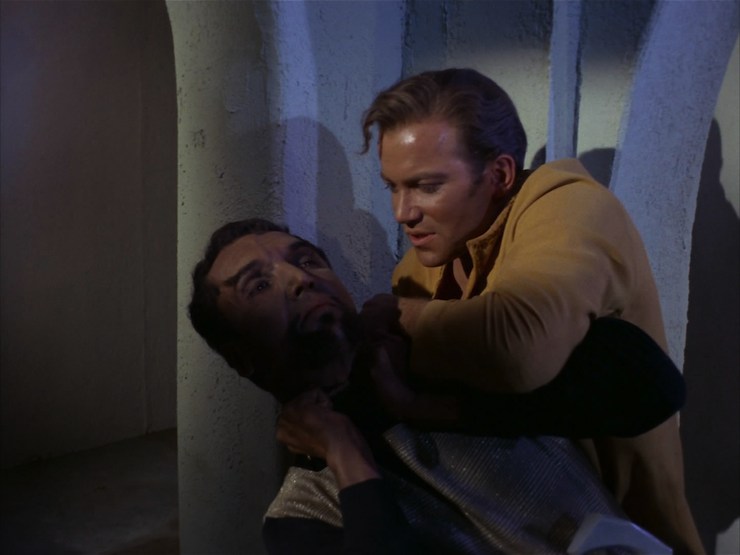
Ayelbourne’s assurance that the Federation and Klingons will become fast friends is seen in the 24th-century spinoffs, in which they are allies (save for a brief period during DS9‘s fourth and fifth seasons) catalyzed by the events of The Undiscovered Country. Apparently, Worf was specifically made into a bridge officer on the Enterprise for TNG in order to show that Ayelbourne’s prediction did indeed come true.
The Organians will be seen again in the Enterprise episode “Observer Effect.” They’re also seen in several bits of tie-in fiction, such as James Blish’s Spock Must Die!, the first four issues of DC’s first monthly Star Trek comic book by Mike W. Barr, Tom Sutton, and Ricardo Villagran, and The Q-Continuum trilogy by Greg Cox.
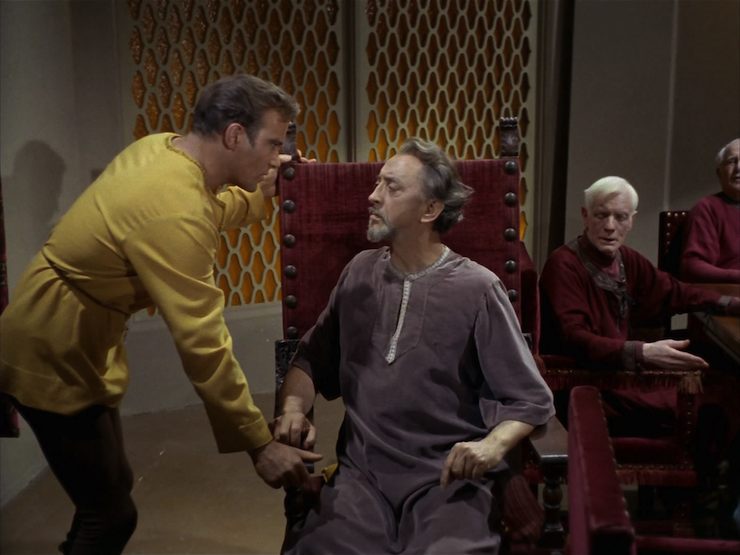
The episode’s title comes from The Life and Adventures of Nicholas Nickleby by Charles Dickens: “It is an errand of mercy which brings me here. Pray, let me discharge it.”
It had been intended to bring Colicos back as Kor in both “The Trouble with Tribbles” and “Day of the Dove,” but he was unavailable each time, and so different Klingons were substituted. An episode was written for Kor for the fourth season, but the show was cancelled.
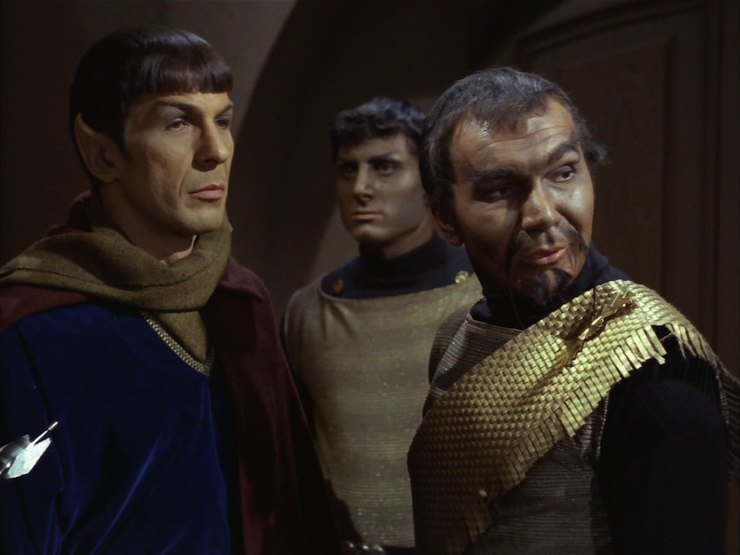
An issue of the Blood Will Tell comic book by Scott & David Tipton and David Messina told this story from the Klingon perspective.
Kor makes dozens of subsequent appearances in tie-in fiction as well, far too numerous to name here, but a few of them include the aforementioned Spock Must Die! as well as your humble rewatcher’s “The Unhappy Ones” in Seven Deadly Sins, The Tears of the Singers by Melinda M. Snodgrass, “Though Hell Should Bar the Way” by Greg Cox in Enterprise Logs, “The Leader” by Dave Galanter in Constellations, the graphic novel Debt of Honor by Chris Claremont, Adam Hughes, and Karl Story, The Centre Cannot Hold by Mike W. Barr (part of the Mere Anarchy miniseries), Forged in Fire by Andy Mangels & Michael A. Martin, and the TOS and DS9 installments of the Day of Honor miniseries (by, respectively, Dean Wesley Smith & Kristine Kathryn Rusch and L.A. Graf).
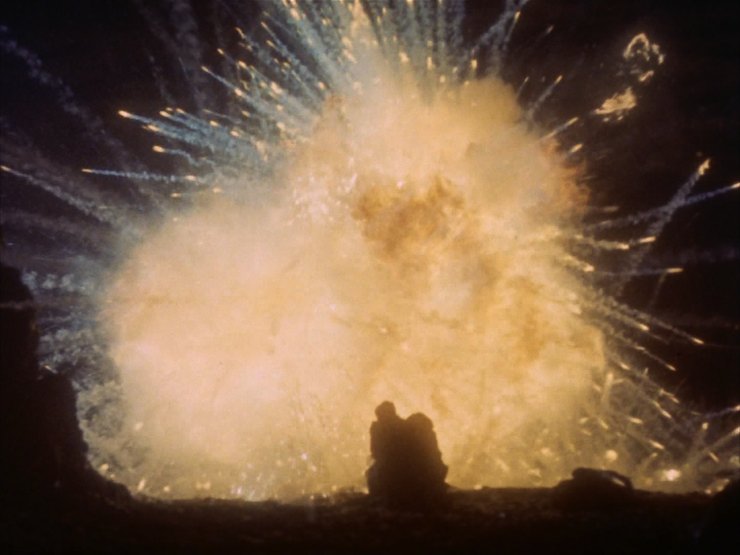
To boldly go. “It would have been glorious.” I am, of course, predisposed to like this episode, given the metric buttload of Klingon fiction I’ve written over the years, but even if we never saw the Klingons again, this would be a strong episode.
For starters, there’s Kirk’s frustration with the Organians, who seem utterly oblivious to the danger that awaits them, which William Shatner beautifully plays. Then there’s the Organians themselves. Watching the episode knowing the ending is even more entertaining, because when you’re aware that the Organians are beings of pure energy who mostly just want the noisy kids to get off their lawn, it makes it all the more delightful. Their behavior is actually very consistent with that, just wanting to be left alone but also wanting no one else to get hurt. You can see why Kirk and Kor don’t get it, though. Indeed, knowing the truth, Kirk comes across as hilariously self-righteous, arrogant, and naïve all at the same time when he offers medical, technical, and scientific help for the Organians alongside the military aid.
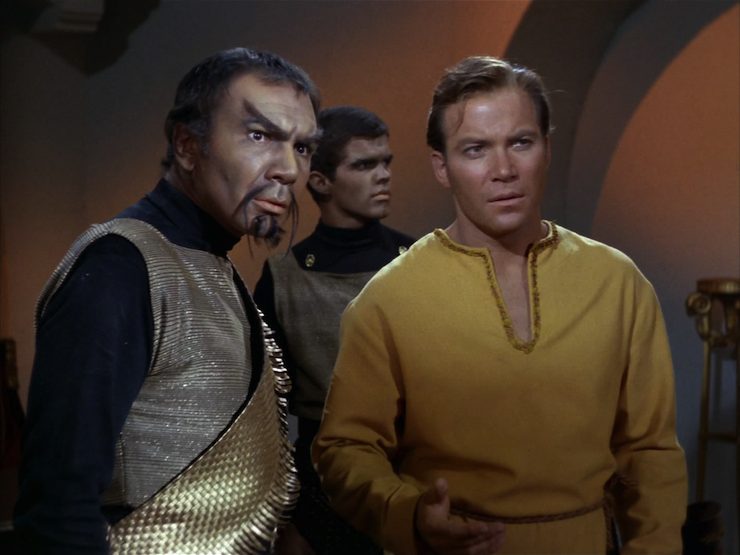
But the standout is, of course, John Colicos. There’s a belief among a segment of the Trek fan base that views the Klingons as changed significantly between the original series and the various spinoffs, that they went from being thugs to warriors, but that belief only works if you ignore the character of Kor. Colicos gives us the blueprint for every Klingon that came afterward, and everything from Worf’s tactical acumen on TNG and DS9 to the Kahless clone’s declarations of the joy of battle and combat in TNG‘s “Rightful Heir” to Martok’s dignity on DS9 can trace its roots back to what Colicos does in this episode.
And in the end, we have what has quickly become the trademark of a Gene Coon script: things are not what you think they are, and jumping to conclusions usually leads to you putting your foot in it.
Warp factor rating: 9
Next week: “The City on the Edge of Forever”
Keith R.A. DeCandido has written Kor several times and always loved it: in the Seven Deadly Sins anthology, in his Lost Era novel The Art of the Impossible, and in Enterprises of Great Pitch and Moment in the Slings and Arrows eBook miniseries.










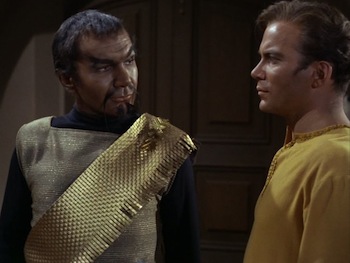
There’s a line from one of the Organians at the end of the episode to the effect that the Klingons and the Federation will be fast friends one day. I wonder if anyone was thinking about that line when they put Worf on the bridge of ST:TNG.
Good episode, but it’s a bit hard to understand the Organians in retrospect. If they didn’t like the company of corporeal beings, why pretend to be corporeal beings? Why not just conceal themselves entirely, or else come right out from the start and reveal themselves as godlike glowy superbeings and say “GET AWAY, YOU BOTHER ME!”? The whole medieval-pacifist cosplay routine didn’t seem to serve much purpose. I guess the idea was to appear inconspicuous, but once both sides were already there and expecting to stay a while, why keep up the act?
One thing I have no trouble understanding, though, is why the Organians were never seen again. A number of tie-in sequels, including the aforementioned Mike Barr comics story and D.C. Fontana’s Year Four: The Enterprise Experiment, have offered explanations for why the Organians “left” and removed the influence that kept the Klingons from warring on the Federation. But I think Gene Coon’s script here gave a perfect explanation for why we shouldn’t have expected the Organians to intervene again. It was made quite clear that they found it repugnant to interact with corporeal beings and only wanted to be left alone. So they’d have no incentive to become activist peacekeepers, monitoring everything the Federation and Klingons did and intervening whenever force was used, as some books have portrayed them. As long as the UFP and the KE left Organia itself alone, the Organians wouldn’t have bothered to intervene. In this interpretation, the “Organian Peace Treaty” itself (not mentioned until “The Trouble With Tribbles”) is probably something worked out between the governments and only signed at Organia or witnessed by them, rather than something the Organians personally impose.
After all, Coon knew this was an episodic series with little to no continuity, since that was the standard in TV at the time. So in the course of introducing a godlike race that could impose its will on the Federation and the Empire, he also had to build in an explanation for why it would only happen once, rather than being the constant status quo from then on.
As for the Klingons… Colicos may have set the standard for all subsequent Klingons, but the other Klingons in this episode, not so much. Victor Lundin’s lieutenant is a pushover, immediately talking when Kirk threatens his life, rather than scoffing at death like later Klingons. Also, he and Colicos are the only Klingons here with facial hair. Throughout TOS, virtually the only bearded Klingons are the ones with dialogue. The background extras here and in “The Trouble With Tribbles” and “Day of the Dove” are mostly clean-shaven (though I think “Dove” has one with a soul patch and maybe one with a thin mustache).
By the way, apparently one of the Klingon extras in this episode was played by Basil Poledouris, the future composer for Conan the Barbarian and RoboCop.
One of the things I like about this episode is that everybody misbehaves – the Klingons (obviously), Kirk (by constantly lecturing the Organians on How to Deal With an Occupying Power), Spock (by agreeing with Kirk), but also the Organians – one main reason why Kirk goes on that suicide mission to ambush Kor is because he doesn’t want any more Organians to die, and none of them bothers to tell him that nobody actually died.
It never bothered me that the Organians kept up their charade for so long because I imagine that that’s what they were used to do whenever someone visited their planet, so they simply stuck to it as long as possible. Maybe ancient immortal beings are not particularly flexible.
#2
I could see the Organians detesting corporeal beings so much that revealing themselves as godlike glowy superbeings would be like taking their clothes off to strangers. Their natural state is only for their “eyes” maybe, so they keep their corporeal clothes on for as long as possible…? Just my theory.
Anyway, this episode is all about the Colicos for me. Great actor. Wish he’d been available for more of TOS, but his DS9 episodes were fun. So I can’t complain.
@4/GeorgeKaplan: Yeah, but then why even bother impersonating the thing you dislike? Why not just make themselves invisible, or go hobnob with the Q and the Thasians on some higher plane of existence until the annoying little meatbags have gone on their merry way?
I wasn’t too happy with ENT’s “Observer Effect” identifying its body-snatching incorporeal explorers as Organians, because they really don’t have anything in common with the Organians seen here. These Organians aren’t interested in studying corporeal life forms or wandering the galaxy or doing much of anything other than placidly existing and contemplating. In my novel The Buried Age, I referenced the “Observer Effect” Organians as an offshoot population that was seen as rather scandalous by the bulk of Organians.
lumineaux: Um, I addressed that in the Trivial Matters section….
—Keith R.A. DeCandido
#5
It’s a scandalous hobby the Organians play. They get to have their men in tights cosplay, watch a couple of dumb corporeal races fight over nothing, then show them the morally superior full monty. It’s very European that. Dig it.
And so you did! Reading comprehension fail.
Do h Vulcan traders normally dress mid 20th Century Hollywood Medieval style?
How many starfarer’s come through such an apparently technologically primitive planet?
It is amusing that Kor and Kirk seem to end up more sympathetic to each other and come to despise the Organians. Them coming clean to Kirk in the first place would have prevented his attempted heroics but maybe hey thought he would not have believed they were as powerful as they showed themselves to be.
While Worf’s presence in TNG’s first season was to show the long term consequence of this episode, his backstory development made his presence in Starfleet have very little to do with the Federation-Klingon Alliance.
So it turns out the Organians are not actually organic
@9/Crusader75: As for Spock’s attire, a trader who comes to a planet to stay for a while might well adopt the local dress to be accepted or simply for convenience.
And there are a lot of SF stories about traders coming to relatively unadvanced planets. There’s historical precedent of European, Chinese, and other advanced cultures trading with less advanced cultures; heck, that’s how Europe got advances like stirrups and the magnetic compass, through trade with the more advanced East. See also European traders in Africa, Polynesia, etc. The locals will likely be interested in your more advanced and exotic goods, and can offer things like local food crops, spices, fabrics, jewelry, and the like that could be of interest back home.
Granted, one would expect the Prime Directive to apply to Federation traders, but it’s never really been clear whether that was a civilian law as well as a Starfleet one. TNG’s “Angel One” stated overtly that the Prime Directive didn’t apply to civilians, though that’s kind of hard to believe. But we’ve seen other worlds where the PD didn’t seem to prohibit contact and trade, like Capella in “Friday’s Child.” We know Organia has already been contacted before the episode, since Spock describes them in his initial report as a “friendly people.” So if they already know about other worlds through prior contacts, then the no-contact part of the PD no longer applies (although the more general “don’t force your values and policies on their culture” aspect still does apply — except in wartime, it seems).
krad: No love for Information Society and “What’s On Your Mind (Pure Energy)” in Trivial Matters? :)
Also, am I the only one who doesn’t need to have some “northern/southern Klingons” or other crazy, tortured notion to explain the widely differing look of Klingons between TOS and the movies? I have no problem accepting “because of bigger budget and cinematic character development”?
@5 My impression of why the organians would masquerade as they did is twofold, if they were invisible there would be risk of other races showing up to take over such a nice viable planet and if they showed their superior energy selves then the greedy would constantly bother them to provide help or advanced technology. So put on an act that makes you to boring to be bothered with until your planet assumes a strategic position in someone else’s war.
@11/critter42 – The fourth season of ENT gave us (what I thought was) a pretty good, canonical explanation for why Klingon appearance changed from TOS to the movies and beyond, so no crazy, tortured notions are really necessary.
I re-read James Blish’s Spock Must Die! (which Keith mentions in his recap) this winter, and was very amused that Blish had the Organians put the Klingon Empire “on ice” for a millennium or something for having violated the treaty in that novel. :)
@11/critter42: I don’t like any of those in-universe explanations either, crazy or otherwise. After all, nobody tries to explain (at least I hope so) why the Andorians’ antennae changed their position, or why Saavik had cosmetic surgery between TWOK and TSFS…
@10/Christopher: I agree that the Prime Directive should apply to civilians too, but in a large galaxy it’s probably difficult to enforce. Also, some low-tech cultures may have been discovered before the Federation came up with the Prime Directive, or even before the Federation existed. In cases like that, it would be reasonable to allow visits and trade while at the same time protecting the planet’s culture.
No one has mentioned the best part of this episode yet. John Colicos saying vegetable, twice. Veg-it-ta-ble. Four gloriously drawn out syllables.
It’s possible the Organians don’t really have a problem with corporeal life on a small scale (the occasional trader, vacationer, or adventurer), but only when that corporeal life starts showing up with fleets and making a racket.
One of the most striking visuals in the entire series, at least for me, comes from this episode. The scene where Kirk blows up the munitions dump. I enjoy it because it associates Kirk – supposedly humanity’s biggest hero and champion in the Roddenberry sense – with apocalyptic visuals, representing the worst human instincts: arrogance, violence, anger, hate, greed, lust, and a barely hidden sense of fear. This was an outstanding effort by Gene Coon, as he depicted Mankind as being every bit as flawed as the Klingons. Why in the world didn’t they being back John Newland to direct more episodes?
Sadly, despite the terrific, plot, characterization and imagery, I can’t help but feel this story was a bit staged. As Christopher pointed out earlier, this was the opposite of Arena. That was as hopeful and optimistic as it could get, while this one had Spock acting a bit out of character in order to make a point regarding human savagery. It’s one thing to be contentuous with the Klingons. It’s another to treat the Organians so shabbily. I guess Coon wanted to make the point of Americans interfering with other cultures in their fight against the USSR, representing the idiocy and stupidity of the Cold War?
Not that the Organians didn’t deserve some of it, or at least they did after cutting everyone’s balls. I definitely don’t understand as to why they kept playing dumb throughout the episode.
I feel Kirk’s gung-ho attitude ends up being better explored in A Private Little War, which I feel is even better than this episode, in terms of conflict with the Klingons and character motivations. Friday’s Child, not so much.
Still, this works pretty well. Tense, conflicted story, serious stakes, introducing a terrific character in the form of Kor. I’m glad we got to revisit him on DS9, for that matter.
@17/Eduardo: When did I say it was the opposite of “Arena”?
@9: Turns out the Organians aren’t actually from Oregon, either.
This seems like an appropriate place to post a link to an article I read last night, as the Federation’s interactions with the Klingons in TOS was a major point of said article:
http://thefederalist.com/2015/09/15/how-star-trek-explains-the-decline-of-liberalism/
I’m actually kind of interested to see people’s opinions on this.
@18: Never mind, you actually didn’t. My mind is playing tricks on me. That’s actually how I feel regarding the episode. For whatever reason, I recalled you writing something like that in a previous comment. It could have been Keith in a previous rewatch, but don’t trust my memory.
@17/Eduardo: Now, that’s interesting, I have quite a different perception of this episode. I wouldn’t say that it’s an opposite to Arena – I think they are rather similar. In both episodes, Kirk behaves very aggressively and comes around due to the intervention of some higher beings. If anything, he’s much more gung-ho in Arena – here he mostly follows orders (“take whatever steps are necessary to prevent the Klingons from using [Organia] as a base”). (On the other hand, not killing the Gorn captain is a much bigger achievement than admitting to being embarrassed, so I guess the differences even out.)
I don’t think the episode is about the Cold War, either – after all, there’s a real war on. I think it’s about what war does to people. Kirk starts off totally sympathetic towards the Organians (“the weak innocents who always seem to be located on the natural invasion routes”) and then drifts more and more towards Kor’s opinion about them without even noticing.
When Kor claims that Kirk and he are alike, he’s right and wrong at the same time. Kirk only sees the differences until he’s caught in the act of actually defending his right to wage war; Kor only sees the similarities. So do the Organians – if they had really understood Kirk and Spock, they could have tried to prevent them from going after Kor by telling them that none of them have died. They could have done that without giving themselves away, just as they could free Kirk and Spock without doing so. If they don’t do it, maybe it’s because they don’t really get that those annoying corporeal beings are actually worried about their countrymen.
I agree that Spock is acting out of character here. I like to imagine that he recognizes Kirk’s flawed attitude, but keeps his opinion to himself out of loyalty. After all, it’s a rather shitty assignment they got here, isn’t it? Sending two people to a strategically important planet on the off chance that there will still be time to organize protection of the natives before the Klingons march in? And to add insult to injury, the natives don’t even want to be protected? I think Spock recognizes that Kirk needs some bitching and goes along with it.
Definitely one of my very favorite episodes. STAR TREK VI: THE UNDISCOVERED COUNTRY serves as a nice, appropriate way to wrap up the long state of hostility between the Federation and the Klingon Empire that was introduced in this episode.
John Colicos RULES as Kor. A shame he was never available for a return visit to TOS. He and Commander Kruge are my all-time favorite Klingons.
I once rewatched all of the TOS Klingon episodes in conjunction with ST VI, and I found that they worked together very well as a series of stories that show the two sides gradually fulfilling Ayelbourne’s prophecy.
In “Day of the Dove,” Kirk and Kang eventually agree to work together against a common enemy.
By the time of THE MOTION PICTURE, relations are good enough that the Federation is receiving open transmissions from the Klingon ships that are confronting V’Ger.
In THE SEARCH FOR SPOCK, it’s established that the Federation and the Klingon Empire now have their own separate Neutral Zone, and Kruge mentions that the Klingons and the Federation are in the middle of negotiating a new peace agreement, which is verified by the Klingon ambassador in THE VOYAGE HOME.
The Genesis Affair obviously put a major strain on UFP/Klingon relations, to the point where the Federation actually cozied up to the ROMULANS for a while. (As established by the Federation President turning to the Romulan ambassador for advice in THE UNDISCOVERED COUNTRY.)
Taken all together, the Federation/Klingon relationship a really nicely done extended storyline that has some twists and turns along the way before finally resolving itself the way “Errand of Mercy” suggested it would. It’s a great standalone episode, and a great foundation for decades-worth of follow-up tales.
@22 Glenn
“By the time of THE MOTION PICTURE, relations are good enough that the Federation is receiving open transmissions from the Klingon ships that are confronting V’Ger.”
I don’t have time right now to re-watch TMP, but I think it was a listening post (e.g. intelligence collection base) that intercepted the Klingon transmissions. The Federation and Klingons were still very much adversarial at this point in history.
@21: One of the reasons I consider it opposite to Arena is related to circunstance. In Arena, they were in a struggle for survival, without even knowing the identity of the Gorn early on. They had no choice but to fight. On this one, Kirk’s always had the option of defying others and leave the Organians at the mercy of the Klingons. As the captain who’s risking his ship and crew, being far away from Starfleet HQ, he has the option of disobeying said others. He chooses not to because in his mind, he has to put the Klingons on their place.
@23: Not only they were still adversarial, there were actual plans of having them attack the Enterprise. One of the film’s early script drafts included a Klingon attack on the ship, following Decker’s merging with V’Ger. In fact, the attack would lead to the first visual depiction of a saucer separation sequence in the franchise. Not many people know the NCC-1701 movie model was designed to separate, same as the TNG 1701-D model. There are actual storyboards for this scene, which can be seen on The Art of Star Trek, a book I’ve owned for 20 years.
@22/Glenn Greenberg: The Klingon Neutral Zone already appears in The Wrath of Khan during the Kobayashi Maru test. (Of course, that may be an imaginary neutral zone made up for the test, but since TSFS takes place shortly after TWOK, I guess it’s a real one.)
@24/Eduardo:They were no longer in a struggle for survival when they followed the Gorn ship. They had the choice to pursue them or let them get away. Whereas in this episode the ship and crew weren’t in danger because Kirk had already ordered Sulu to get to safety instead of fighting the Klingons.So it was really just about himself and Spock.
And “leave the Organians at the mercy of the Klingons”? Besides defying orders (something he rarely does, as we have seen, and also it might entail more severe consequences in times of war), wouldn’t that be a dubious thing to do?
It would definitely be dubious, but not really out of his jurisdiction. He’s far away from home, and he’s the highest ranking officer in the region.
As for the Gorn situation, let’s remember that the episode began with them being relentlessly bombarded by explosions, which resulted in at least two crewmember deaths. They were definitely still on the edge afterwards, and not acting objectively. You don’t recover from a traumatic event overnight.
@27/Eduardo: OK, I agree where the Gorn are concerned, but not about this episode. They’re not on their own here, able to make their own decisions. It’s war, they have their orders. Sending the Enterprise away is as far as he can go. Besides, he obviously wants to protect the Organians. It’s only after their refusal that his protectiveness deteriorates to arrogance.
@23: “The Federation and Klingons were still very much adversarial at this point in history.”
That’s an assumption, not anything established officially.
The TV show had been off the air for 10 years, the Animated Series for 4 years (and that may or may not even count as canon), and clearly, much had changed since last we saw Kirk and crew. Even when I was a kid, the fact that Epsilon 9 was able to receive uncoded transmissions from the Amar–including video footage directly from the ship’s bridge–suggested to me that relations had improved, at least slightly, between the Federation and the Klingons. I felt even more strongly about that when, in THE UNDISCOVERED COUNTRY, the Klingons won’t even admit to the Federation, at least at first, that its moon Praxis exploded.
@24: Needless to say, anything that didn’t make it onto the screen–especially an idea from an early draft of the script–does not count. If it did, then “Kitumba” would be the official, canonical depiction of Klingon culture. All I’m saying is, the UFP and the Klingons weren’t NECESSARILY as hostile toward each other during the time of TMP as they were in the series. That’s the way it seemed to me, based on the opening sequence of TMP.
@25: The Neutral Zone in the Kobayashi Maru test in THE WRATH OF KHAN is located near the Gamma Hydra system. As established in “The Deadly Years,” that would make it the ROMULAN Neutral Zone. Why are Klingon ships (as opposed to Romulan ships using the Klingon design) lurking in the Romulan Neutral Zone?
1) It’s only a test, it doesn’t have to be 100% accurate.
2) Ask Nicholas Meyer–it’s his script! :-)
@29: Or 3) A test run of Romulan telepresence devices, if you go by the Ent relaunch :D
(it presents the events of the Kobayashi Maru test as based on real events that occurred shortly prior to the Earth-Romulan War)
@23/Ragnarredbeard: Yes, that’s always been my take: That Epsilon IX was a listening station monitoring enemy transmissions, the same way the US and the Soviet Union listened to each other’s broadcasts and sifted them for whatever intelligence they could.
The Epsilon IX lieutenant actually says to Commander Branch, “Our sensor drone is intercepting this on Quad L14.” That sounds pretty clandestine to me. If it had been an open transmission between friendly neighbors, the word “intercepting” would probably not be used, and a sensor drone would probably not be necessary.
According to the TMP novelization by Gene Roddenberry, Epsilon IX had launched sensor drones specifically to “infiltrate the cruiser formation,” with the Klingons too distracted by V’Ger to realize they were being monitored. It adds that the drones were launched to gather intelligence on the new Klingon cruiser design, and just happened to be monitoring when they discovered that the cruisers had been sent to intercept the mysterious intruder that later turned out to be V’Ger.
@24/Eduardo: The Federation was in a declared state of war during this episode. Kirk would not have had the same latitude to interpret his orders that he would have in peacetime. Refusing to follow his orders in wartime would have probably been considered treason.
@29/Glenn: Why assume the Amar transmissions were uncoded? I figure that Epsilon 9 had simply broken the code.
And hold on — didn’t you write Star Trek: Untold Voyages, whose first issue is set right after TMP and shows a Klingon captain trying to capture the Enterprise so the Empire can learn its specs and gain a military advantage? That seems pretty adversarial to me.
I much prefer the TOS Klingons and Romulans to that which they became in later Trek.
Kor is just delightful in this episode.
@31: “And hold on — didn’t you write Star Trek: Untold Voyages, whose first issue is set right after TMP and shows a Klingon captain trying to capture the Enterprise so the Empire can learn its specs and gain a military advantage? That seems pretty adversarial to me.”
Not canonical, as you well know.
And that’s the beauty of that period in Trek history–so little about it is written in stone, you can go anywhere you want in terms of the overall status quo of the Star Trek universe, more or less. Had I wanted to show that everything was peachy-keen between the Federation and the Klingon Empire during that moment of time, and I had a good reason for it, I probably could have done it.
Incidentally, I was actually going to acknowledge in my earlier post that this is all coming from someone who had the Klingons engage in battle with the Enterprise right on the heels of TMP, but I ended up taking it out because I didn’t want to come off as forcing in a plug for my own work. (So thanks for doing it for me, CLB!)
Futhermore, I established in UNTOLD VOYAGES #1 that the Klingons were guests in Federation space, that they were on their way to Earth as part of a diplomatic, information-sharing mission in the wake of the V’Ger Incident–the Klingons lost three ships but Earth was somehow spared, and the Klingons wanted an explanation, which the Federation agreed to provide (suggesting the possible improved, more open relations between the two governments that I referred to earlier). But upon seeing the spanking-new refitted Enterprise, the commander of the Klingon flagship immediately reverts to type and decides it’s more important to capture the ship and its state-of-the-art technology.
So I pretty much played it BOTH ways. No real inconsistency there.
How odd, the Netflix subtitles call him Barona, consistently…
@33/Glenn: Canon has nothing to do with it. I just figured that you’d write stories that reflected your view of the universe and setting.
It seems to me that the UFP would’ve been willing to invite the Klingons to that conference in any case — indeed, in an adversarial climate, it’d be even more important to explain V’Ger to them and stave off the risk that they’d see it as a Federation attack. It’s when relations are hostile that peaceful dialogue is most urgently needed. If relations were good, that suspicion and the risks it posed wouldn’t have been as great, and a simple subspace communique between governments would probably have been enough. So to me, your story’s premise reinforced the idea that relations with the Klingons were not good at that point, that the enmity was as great as ever. Which, again, is what the movie itself suggests, with Epsilon IX’s sensor drone “intercepting” the transmissions rather than the Klingons voluntarily sharing them.
Anyway, this does illustrate a structural flaw in TMP — a movie that I love, but with full awareness of its weaknesses. It makes such a point of reintroducing and reinventing the Klingons, putting them right up front at the top of the movie, and then not having them play any further role in the plot. I’ve read that it was confusing to new viewers — who were these bumpy-headed guys and what were they doing there? One film critic rather notoriously came away with the impression that they were the aliens piloting V’ger.
@35/CLB: An interesting interpretation of what was going on in my story, especially since what you gleaned from it was not what I had in mind! But I appreciate where you’re coming from, and that you obviously gave it some real consideration, given the points you raised.
One reviewer did an analysis of the entire UNTOLD VOYAGES series that blew my mind because he read so much into it and saw an agenda on my part that was so TOTALLY not there–but when he presented his reasons for interpreting the series that way, I had to admit that I could see where he came up with his notions about it.
@35/Christopher – If the Klingons confused some viewers in TMP, they confused some viewers, but I don’t think that means it was a “structural flaw” to include them. The Klingons are there as a plot device. Their sole function is to illustrate the destructive power of V’Ger. It doesn’t even really matter that they are Klingons; that is basically a “gimme” to the fans (“Hey, look, we got your Klingons… sorta…”). What matters is they are V’Ger fodder. We watch three big, bad, alien ships get blown away (so far as we know) by a bigger and badder “thing” on a direct heading for Earth. If it were a weekly episode, we’d cut to the opening credits at that point.
If the Klingons had come back at the end (interesting, @24/Eduardo – I had know about the intent to separate the saucer in TMP, but not the context), that would’ve been a structural flaw, because that would be totally unrelated to the story TMP was telling. Now, it could’ve kicked off a sequel, a la the way Superman inadvertently freeing the Phantom Zone villiains in the original falling action of Superman (1978) would’ve set up Superman II… but a Klingon attack in the final reel of TMP would’ve been, I think, even more confusing than their bumpy-headed appearance in the first reel.
I like “Errand of Mercy,” although it’s not one I frequently rewatch because I find it kind of slow. But Colicos is great as Kor, and I like Keith’s point that Colicos’ performance plants the seeds not only for TOS Klingons but for their development in the various later series.
@37/MikePoteet: My problem is that the Klingon sequence creates expectations that weren’t met. If it had been some random Starfleet ship, say, or if they’d opened with Epsilon IX being digitized, then it could’ve worked as a simple inciting teaser incident. But it was this big impressive introduction of the reinvented Klingons, and it seemed to be building them up as a big deal. We open with a long flyby of a trio of Klingon ships that goes the iconic Star Wars opening shot one better by having a motion-control camera move that swings around to follow the ships — people today don’t remember what a spectacular innovation that was at the time — and then we see the Klingons inside, and they’re so impressively alien now with a weird appearance and their own language, and it’s this big grand set piece that creates the expectation that these guys are important to the story to come. And then they just get wiped out and there’s no followup, no more role for them except in the crew-briefing scene. So much work was put into giving them a hugely impressive scene right at the start of the movie, and I believe the reinvention of the Klingons got a lot of publicity at the time, but it’s nothing more than a cameo.
Sure, a lot of movies start with an incident unconnected to the rest of the film, like the opening sequences of James Bond or Indiana Jones films. But in those, the focus is on the hero, not the throwaway villains. They remain in the background, so you don’t get the expectation that they’ll be major players in the story ahead. In this case, V’Ger would be the equivalent of Bond, the unifying element between the teaser and the main story, but the focus of the teaser is on the Klingons instead, very emphatically. It’s like doing the opening of Raiders of the Lost Ark entirely from the perspective of the Hovitos.
More than any other, I think the biggest purpose of the Klingon teaser in The Motion Picture was for the filmmakers to be able to show viewers how different the movie was from the TV show, in terms of resources, visual effects and production values. I wasn’t born in 1979, but I can imagine the loud reactions in a crowded theater to the film’s opening sequence, from the superb Goldsmith-scored credits to the destruction of the Klingons. It would have been as striking as the overhead chasing Star Destroyer in SW Episode IV, back in 1977.
Plot-wise, they serve their purpose, being the disposable Redshirts, in order to visualize the overwhelming power of V’Ger, without shedding Starfleet blood in advance, and saving the Epsilon IX event for later.
One of the things I love about TNG was their method for abusing the redshirt trope, without actually killing nameless extras. As Ron Moore and Brannon Braga brilliantly described in the First Contact DVD commentary, “if you want to show to the audience that an enemy is powerful, have him kick Worf’s ass”.
Just a thought: could the reinvented Klingons just be because of the thinking that since this was now a big Hollywood movie, they needed to spend a ton of money on things, like the new costumes, makeup and sets?
Whoops, Eduardo kind of beat me to it.
@39/Eduardo: All that is true, but I’m thinking in terms of Chekhov’s maxim: If there’s a gun on the wall in the first act, it should be fired in the third. Having something play a big role in only one scene and then vanish for the rest of the story feels awkward. I’ve done it myself — e.g. giving Captain Terrell only one scene in Mere Anarchy: The Darkness Drops Again, and while that’s one of my favorite scenes that I’ve ever written, it bugs me that it’s so disconnected from the rest.
@42: Agreed. There should always be some sort of payoff, even if it is merely a subtle nod.
The Klingons were clearly meant to play a bigger role in earlier versions of that film, hence why I brought up the surprise attack plot which would’ve led to the saucer separation. If it was storyboarded, then it was clearly written on script at some point (probably lost amongst the numerous rewrites). I imagine the Klingons would have blamed Starfleet over their losses on the V’Ger incident, which would have led to the attack.
Given the film’s runtime of 130 minutes (142, if you include the 1983 TV edition), plus the rushed post-production schedule, there’s obviously no way they were going to be able to include this whole epilogue. It would still have felt artificial, even if it were directly related to the film’s opening.
@43/Eduardo: I don’t remember precisely, but I think Andrew Probert’s storyboard of the attack and saucer separation sequence was part of a pitch for a possible alternate ending, rather than something that was ever actually in the script. The script was being rewritten as they shot, the specifics of the ending hadn’t been decided on yet, and there were a lot of competing proposals from various people involved with the film.
Eh, I guess we’ll agree to disagree – The “Chekhov’s gun” is V’Ger, not the Klingons. I also think the insertion of Epsilon IX prevents the “teaser” from being totally from the Klingons’ p.o.v., and signals to the viewer that we, like Cmdr. Branch and crew, are supposed to be watching this incident through Starfleet/Federation eyes: What does this mean for us? Especially since, watch out, that thing’s headed for Earth?
I meant to ask earlier: In TNG season 1, is Michael Dorn wearing the actual same sash that Colicos wore? What led to his sash changing in season 2 and beyond – simply the fact that Colicos’ wardrobe was 25 years old by that point? Have any tie-in authors ever tackled the question of why Worf was wearing Kor’s sash? Is Lt. Worf related to Kor as well as Colonel Worf of ST VI?
@45/MikePoteet – According to the Christie’s auction, it was reportedly the same sash. There’s a little more info over on TrekBBS that indicates it was the same one, but it was falling apart and they had to switch.
@45/MikePoteet: There isn’t only one Chekhov’s Gun in a story. The point is that every element in a story should serve a purpose — that you shouldn’t include a detail in a story if it isn’t important to what comes later. If you don’t need that gun to come into play, don’t put it on the wall at all.
(Perhaps the best ever screen illustration of this principle is Back to the Future. Essentially every single line and detail in the movie has a payoff later on. It’s a remarkably tight story structure.)
Honestly, I only recently started questioning the Klingon sequence in TMP. I grew up with this story, so I always kind of took its structure for granted. But when I read Return to Tomorrow, the huge “oral history” tome of interviews with the various filmmakers, and saw all this discussion of all the lengths they went to in order to reinvent the Klingons and create this stunning opening scene, it just struck me how disconnected the Klingons were from the rest of the story, how they were just there for a cameo appearance and then gone. It just seemed like an anticlimax.
@47/Christopher – That’s a fair point.
I’ve never questioned the sequence, either (obviously). The purpose of establishing V’Ger as a threat seems so effectively accomplished, I simply never thought to look for more.
I have on occasion, however, wondered about the poor commander Mark Lenard plays under all that bumpy latex (as the clerks wonder about the independent contractors on the Death Star…). I’m not sure if going out as a glowing blue-green blaze of data patterned for storage counts as a death with honor!
And I remember Leslie Thompson, in an early Best of Trek volume, railing against the Klingons’ actions in the sequence, claiming it was all out of character and too “beserker”ish. I’m not convinced – presumably, V’Ger had destroyed some Klingon ships or planets along its way, and the Empire was out to avenge its losses – but I guess it could be seen as foolhardy to go up against the cloud, especially when the Klingons must know it’s headed straight for Earth, too.
@48/MikePoteet: An alternate-timeline version of Lenard’s Amar commander (under the name Barak, taken from an early script draft) appears in my Department of Temporal Investigations novel Forgotten History.
@19/crzydroid: Since nobody else has given an opinion so far, I’ll give it a try, though I’m not particularly qualified – I’m not even sure what “American liberalism” is. I don’t feel up to commenting on all the points made in the article, either, or I’ll be up all night, so I’ll mostly talk about the first paragraphs.
The author claims that TOS Star Trek is about sixties values like “universal freedom […], prosperity, technological progress, and […] universal humanity”, that later incarnations of Star Trek embrace “relativism” instead (I’m leaving out the last section about the reboot), and that that is a bad thing.
The first thing that bothers me here is that Star Trek is about a lot of themes, and most of them are not particularly “sixties” – which is why it has aged so well. Think of all the anti-war episodes we’ve rewatched, the recurring themes of compassion, equality, diversity, mutual help,…
Well, the author isn’t interested in any of those. Instead he cites the following episodes to back up his claim: The Omega Glory, Friday’s Child, Return of the Archons, and The Apple. He calls the last one “perhaps the quintessential episode of the original Star Trek“. Yup. The Apple. Not Arena or The Devil in the Dark or Mirror, Mirror.
Second, his Kirk is never wrong. Sometimes he doesn’t seem to get the story that’s actually there. For example, when talking about Errand of Mercy, he praises Kirk for being disgusted with the Organians because that means he “recognizes that peace without freedom is not truly peace”. What about the Organians’ freedom to make their own choices? (I guess that would qualify as relativism, and relativism is wrong.)
In exchange for this, he’s quite critical of Spock: “Spock – who in later episodes invokes the Vulcan slogan celebrating ‘infinite diversity in infinite combinations’ – is comfortable observing Vaal’s servants nonjudgmentally, like specimens behind glass.” Yes, I guess IDIC is relativism too. But it’s right there in the original series, and the characters seem to agree that it’s a good thing, so where’s the “clear-headedness” he praises? This whole line of reasoning only works because he cherry-picks his arguments (and his episodes).
As far as I understand, liberalism is an ideology, both social and economical.
I didn’t care for that article. Way too one-sided in its attempts to demonize relativism. I got the impression that his views on freedom and justice were absolute, and any other viewpoints that challenge those ideals weren’t worth discussing.
@22 Glenn Greenberg: I agree with your conclusion on how well the Klingon evolution holds together! That’s why I’ve always felt there should have been at least a wink and nod to the Organians in The Way of the Warrior.
@43 Eduardo and @44 Christopher: I can’t find it right now, but I remember reading somewhere online that there was also a plan to separate the Saucer in TMP to use the drive section as a bomb when Kirk was considering using the self-destruct sequence to neutralize V’Ger at the end of the movie (General Order 24 or whatever it was they mentioned in dialogue).
@51/Eduardo: My problem was that liberalism means something different in Germany. I’m under the impression that in the USA, liberalism is somehow left-wing, which it totally isn’t in Germany. It’s not important, it just means that I can’t comment on some of the article’s claims.
I agree with your view on the article, and it irks me that he tries to co-opt TOS. The whole idea of the Prime Directive shows that he’s mistaken. I think that respecting others’ customs and values and upholding universal values both have their merits, it’s a fine line to walk, and in most of the episodes, original Star Trek manages really well. But of course those are not the episodes the article references.
@53/Jana: The association of liberals, progressives, and other change-oriented factions with the left wing and conservatives and preservers of the status quo on the right wing goes back to the French Revolution and the way the royalist and revolutionary factions were seated in the National Assembly. So yes, liberals are considered left of center in Western usage in general, though current American political discourse tends to be dominated by extreme right-wing voices who paint themselves as moderates and everyone else as extreme left-wing radicals, even people who would’ve been considered conservative 30 years ago. So I’m not sure what you’re hearing about US politics or what exactly you mean by “left-wing.” What does liberalism mean in Germany?
@54/Christopher: Um, let me start by saying that I’m out of my depth here. I don’t know enough about political theory to deliver sound definitions. I did say that I’m not really qualified to comment on the article, didn’t I?
Sigh. OK, I’ll try anyway. This seems to be my week for long posts.
I start by explaining what I meant by “left-wing” because I’m not sure if I used the term correctly. I didn’t mean anything extremist, just a number of political ideas that tend to appear together, at least where I come from – ideas like equality, workers’ rights, feminism, protecting minorities, respecting cultural differences, a welfare state, environmental consciousness, and probably some others I didn’t think of right now. Some people would say, also a tendency to rule via prohibitions and regulations. (I’m quite a fan of most of the stuff mentioned above, but I’m less comfortable with the prohibitions and regulations.)
You’re right about the French Revolution, of course, and I guess that makes the current situation in Germany seem a bit weird.
So, what does liberalism currently mean in Germany?
There’s a liberal party, called FDP, short for “Freie Demokratische Partei” (Free Democratic Party), and they define very much what people understand by “liberal”, so I’ll tell you what they stand for.
They’ve been around since 1948. They used to be part of the government for a long time, alternately in a coalition with the (conservative) CDU and the (social democratic) SPD. This changed at the turn of the millenium. Today’s situation is that there’s two additional parties within the spectrum of the left (as defined above), and that the CDU has moved a little to the left too. An FDP voter recently told me that the FDP was the only conservative party left.
What they stand for: Less paternalism. Less government interference. Less regulations. Less taxes. Privatisation. Supporting companies and the economy. Willingness to perform. Optimism for the future. Equal rights for same-sex couples (which used to be very much a left-wing demand in my youth, so that’s kinda cool for “the only conservative party left”).
I hope this helps, and I hope I didn’t misrepresent anyone’s position. I tried to be impartial.
@55/Jana: Hmm. Except for the same-sex rights, that all sounds really conservative by US definitions. Just goes to show how partisan labels can be redefined.
@56/Christopher: Yes, it’s weird, isn’t it? It bugs me too because I’m very much in favor of the idea of freedom, but I just can’t vote for this party.
Hey folks! I have a 22 September deadline for revisions on my Stargate SG-1 novel Kali’s Wrath, so I’m pounding away on those. This means the rewatch of “The City on the Edge of Forever” will not happen until Wednesday.
—Keith R.A. DeCandido
Hey folks! Illness has delayed both my finishing of Kali’s Wrath revisions and my rewatch of “The City on the Edge of Forever.” It will now go up on Friday morning. Later that day, look for an announcement of what my next rewatch will be!
—Keith R.A. DeCandido
Feel better soon, Keith! Hopefully you are not feeling as poorly as McCoy when he woke up in Edith Keeler’s mission…
I watched this episode for the first time earlier this year. As a pacifist (as you might guess from my name), I think I had a different take on it than many. The significance of this episode to me had nothing to do with it being the introduction of the Klingons to Star Trek. The scene where the Organians forced both sides to stop fighting by disabling their weapons made me think that perhaps ultimately, that is the only way that violence in human society can be overcome. Either by intervention from a more-evolved species, or by evolving beyond the need for violence ourselves.
I’d like to think we don’t need to transcend our corporeal bodies to finally lay down arms. But seeing the history and current state of the world makes me so cynical about humanity that I’m really not sure. (I’m also an atheist, so I don’t hold out hope for divine intervention by any conventional religious sense of the term.)
@61/Pax: I’m more partial to the “A Taste of Armageddon” solution: “I will not kill today.” Violence is part of our nature, but so is choice. We can always choose not to use violence. The problem is that too many people construct narratives claiming that someone else’s actions left them no choice but to use violence, so they convince themselves it was inevitable. We need to remember that it’s always our choice, and that we can choose to say “I will not kill today.” Which doesn’t mean we can kill tomorrow — it just means that we must remember every single day that the choice is ours. And it means that it’s useless to wait for some future event like “evolving out of it.” We have the power here and now, today, to regulate our own violence. Saying we have to wait for a future event or an external intervention to save us from it is just another way of evading responsibility for making that choice here and now.
Wow, I never knew that they wanted to bring Kor back for two other episodes in TOS. It would have made for an interest change in pace for an era so set against continuity.
@2 – Chris. Maybe the lieutenant that spoke when threathened was the one cowardly Klingon who is the exception to the Planet of Hats rule for the Empire? (Klingon Imperial Empire, to quote Picard.) And cool about Poledouris, good to know.
@19 – crzydroid: That Federalist article looks interesting from my skimming of it, but it’s soooo long, and I have to catch up on these rewatches…
@35 – Chris: The movie critic who thought the Klingons were piloting V’Ger doesn’t sound too bright.
@51 – Eduardo Jencarelli: Be careful, do keep in mind that for English speaking people “liberalism” is very close to what “socialism” is for us Latin-derived languages speakers: pro equal rights for all, strong labor laws, regulations for corporations, etc, paternalist state with lots of social services, etc; while for us, “liberalism” is about small government, free market, etc. I believe it means the same in Portuguese as in Spanish… and I’m sorry if you already knew this. :)
@53 – JanaJansen: Ah, Liberalism means the same in German as in Spanish, I see.
@54 – Chris: I’m late to the comments thread, but no, “liberalism” does not mean the same in “Western usage in general”; as it means something completely different in Spanish than in English, as I explained above. What Jana said, too. :)
@63/lordmagnusen: Well, just because ’60s shows tended to be episodic, that doesn’t mean they never had recurring villains. The Wild Wild West had Miguelito Loveless, The Fugitive had the one-armed man, and of course Batman had a ton of recurring baddies. And Harry Mudd appeared twice in TOS and once in TAS.
No, of course, I watched many of those shows as well. But it would have been a nice addition to TOS, since besides Harry Mudd, there weren’t any other recurring villains on the show, and Colicos’ Kor was definitely something else.
Oh, no argument there. More Kor would’ve been terrific. (And if only TAS could’ve gotten Colicos to reprise his role in “The Time Trap.” They got Mark Lenard, Roger C. Carmel, and Stanley Adams, after all.)
Raise your hand if you hate the Organians. Yeah, me too. Condescending paternalistic Bs.
Kor did return twice in Deep Space Nine.
The Organian Peace Treaty seemed to cause more problems than it solved. It wouldn’t be until a truly permanent one, the historic Khitomer Accords, happened, entirely without their involvement, that there would be real peace.
Overall, this was a much better antiwar episode than “A Private Little War.” Ayelborne’s speech to Kirk is classic and really challenges the Starfleet “good guys” on what their beliefs really are.
@68/mspence: “The Organian peace treaty seemed to cause more problems than it solved.”
Since the alternative would have been interstellar war, I wouldn’t say that.
The first season had quite a few good antiwar episodes: this one, “Balance of Terror”, “Arena”, and “A Taste of Armageddon”.
@68/mspence: “The Organian Peace Treaty seemed to cause more problems than it solved.”
That’s just because fiction has a built-in selection bias in favor of problem situations. In the cases where the treaty solved or prevented problems, there’d be no story to tell. So we have no idea how many problems it did successfully solve. (Aside from the one big problem that Jana brought up.)
Anyway, I disagree — the problems in stories like “The Trouble with Tribbles” and “A Private Little War” weren’t caused by the treaty, they were caused by the Klingons’ attempts to cheat their way around the treaty. And without the treaty, they would’ve gone for open invasion rather than infiltration and espionage, so I’d say the treaty did prevent the problems from being far worse than they were. I’d argue that the treaty did solve the problem in “Tribbles,” because once Koloth’s violation of the treaty was exposed, he had to slink off for fear of treaty penalties rather than just trying to blow up the station or something. Treaties, like laws, can’t prevent people from trying to violate them, but they can impose enforceable penalties on those who are caught in the attempt.
@68
Look at it this way, while it makes our heroes have to work harder in the small scale and no doubt gives them a more stressful time as they try to fit it in around their regular job; in the larger scale an interstellar war would have had a death toll in the millions, if not billions, and while technically our heroes job would be simpler (see Klingon, shoot Klingon), that simplicity that not having the Organian treaty in place for would have come at a massive death toll. A lesson in life that the simple way is seldom the right way, even if it would make life easier on you personally. Doing the right thing is hard but ultimately worth it, and that is a lesson that Star Trek (at least up until DS9’s later seasons) took great pains to show us. It is just a shame we didn’t learn it better for the opening years of the 21stC.
@69/JanaJensen Good point, I hadn’t picked up on the number of quality anti-war episodes aired in the first season (very much a reflection of the time) and not quite as heavy handed or blatant as later episodes with the same sentiment
@68/mspace I’ve always loved (and quoted/paraphrased) that speech as well…Really hit me when I happened to see it on local TV in late 1990 during the run up to the first Gulf War, and eleven years later when I watched on video just after 9/11…
This is my favourite episode and Ayelborne is my favourite character. However, if this is such a backward society where did they get the electronic door from? Wasn’t that a clue for Spock and Kirk?
@73/Philip Rushe: People have been asking that question for half a century, and the self-opening doors were meant to be a subtle clue to the audience that there was more than met the eye. Perhaps Kirk and Spock were just too preoccupied with the Klingon threat to notice, though that’s less plausible for Spock than for Kirk.
Then again, self-opening doors don’t have to be electronic. There’s a long history of ancient civilizations devising clever mechanical tricks to create the illusion of magic or divine phenomena like moving statues or the like. There could’ve been some kind of gear-and-pulley system being operated by servants hidden behind the walls — not unlike how the doors would actually have been operated by the stagehands on set.
Definitely one of my favorite episodes of TOS. The only complaint I have is the hilarious woodeness of Kor’s first officer. He talks in almost complete monotone during his report on Spock’s interrogation and then again when he’s reporting Kirk and Spock’s escape. He only shows a hint of emotion while he’s being garroted by Kirk.
@9
Gene Rodenberry came to Portland many years ago and presented a Star Trek show at Memorial Coliseum. He showed the 2 hour uncut pilot for the series, some outtakes, bloopers and told anecdotes.
He told the crowd that he modeled the Organians after Oregonians, specifically that they were peaceniks. The crowd cheered.
@76/Oregonian: “He told the crowd that he modeled the Organians after Oregonians, specifically that they were peaceniks. The crowd cheered.”
Typical Roddenberry egotism, taking credit for other people’s creations (Gene L. Coon’s in this case).
Late to this rewatch but here goes…A few years ago I watched all of Space 1999. It seemed like a lot of their interactions with aliens ended up being with “superior” beings. often non-corporeal. Eventually I found it irritating yet when I thought about how many advanced, even god-like, beings TOS interacted with it wasn’t irritating. I finally realized it was because however powerful the aliens were, the stores were still human stories. However far in the future the stories occurred they were human stories and so relatable.
If I was forced to pick the very best Star Trek-TOS episode, it might be this one. “Errand of Mercy” is perfect from beginning to end. Interesting story, lots of mystery and suspense, strange, compelling aliens, nice touches of humor, some good action sequences, superb acting, and a twist, thought-provoking ending, For me, the highlight was (of course) John Colicos and Commander Kor. Unlike most other Klingons the show would later have, Kor was a well-rounded, complex character – yes, he was a brutal dictator, but he was highly intelligent, philosophical and even had a sense of humor. And I loved how it showed how very similar the supposed “enemies” Kirk and Kor was. I wish other Klingons were as well thought out as Kor was (maybe only Kang came close). And also notice that this episode had NO McCoy nor Scotty. Were they even that necessary to the show?
@79/Gooch7: “And also notice that this episode had NO McCoy nor Scotty. Were they even that necessary to the show?”
In season 1, Shatner and Nimoy were the only regular cast members, the only ones required to appear in every episode, though Kelley was in all but a couple. Originally, Kelley and Grace Lee Whitney were about equal in importance, but then Whitney left the show; and of course, Kelley was promoted to full regular in season 2. The others were just recurring players, contracted for a limited number of episodes per season. After the main three, Nichelle Nichols was in the most episodes, then James Doohan, then George Takei, and of course Walter Koenig was in the fewest since he wasn’t added until season 2.
After many years of being burned at jobs by supervisors and coworkers who like to smile to your face and stab you in the back, I have adapted Kor’s wisdom and applied it to work. I don’t trust people who smile too much. I would rather have someone declare their hostility outright. Good, honest hatred. Very refreshing!
John Colicos; Best Klingon Ever! Kang and Koloth are great too but Kor is the mold.
In the James Blish version of this episode, as I recall, the Klingons are described as being of “Oriental” origin!! Thus would suggest they are originally from Earth! I don’t know if Blish based this on an earlier draft of the script of if he was inserting his own fanciful interpretation. I don’t think I saw anything about Klingons coming from Earth anywhere else!
Palash Ghosh: The Klingons were originally described as looking like Mongols, and made up that way, too, so that’s probably what Blish — who was only working from shooting scripts, sometimes early drafts of same — based it on.
—Keith R.A. DeCandido
@83/Palash Ghosh: Blish’s exact wording was “originally of Oriental stock,” which certainly seems to imply they’re descended from humans, but it’s conceivable he meant they were from a humanoid origin that paralleled Asians.
@84/krad: Blish also refers to the Klingons’ “Mongol-like features” in the “Day of the Dove” adaptation. Although that was in Star Trek 11, so I’m not sure if it was Blish or J.A. Lawrence writing them at that point.
(When I was checking my Blish collections for Klingon episodes, I was surprised to discover that he based “Friday’s Child” on a draft that apparently hadn’t had Klingons added to it yet, and that was also set on Ceres instead of Capella.)
A former girlfriend of mine had a unique perspective on Kor which I don’t think has been discussed elsewhere. Watching this episode, she blurted out: “That Kor guy’s got a crush on Kirk!” She claimed Kor was very attracted to Kirk and had sexual “designs” on him. She compared Kor to the sadistic Turkish commander in the film ‘Lawrence of Arabia’ who was clearly enamored with Lawrence and likely raped him. When Kor thought Kirk was an Organian named Baroner, Kor noticed Baroner was serious, grim and brave (which he seemed to admire). When Kor realized who Kirk really was, he seemed overjoyed by the revelation. My ex-gf suggested that the scene in Kor’s office where he offered Kirk some booze was a “seduction attempt” scene. I didn’t totally buy her theory, but I found it intriguing. And obviously, a 1966 TV show could not possibly refer to gay relationships.